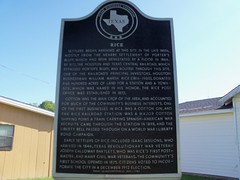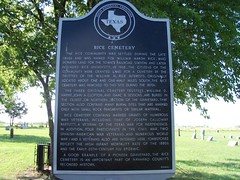William Marsh Rice
Commemorated on 8 plaques
Texas Historical Marker #07194
First Baptist Church of Rice. On Feb. 21, 1875, three years after a rail line was built to the area, a group of local residents met to organize this congregation. Early worship services were conducted in the community schoolhouse. In 1894 a sanctuary was constructed at this site on land acquired from Rice Institute, a Houston organization founded by railroadman William Marsh Rice, for whom this town was named. For over a century, the First Baptist Church has led in the development of the area. Its role in the community continues to reflect the ideals of its pioneer founders. #7194
201 S. Dallas, Rice, TX, United States where they funded
Texas Historical Marker #08992
Buffalo Bayou, Brazos & Colorado, First Railroad in Texas. Planned 1840 to benefit the Republic of Texas by moving rich sugar and cotton crops from plantation areas. Chartered 1841 by 5th Congress of the Republic, in name of Harrisburg Railroad & Trading Company. H. R. & T. C. did not succeed in building a railroad. Its holdings were transferred in 1847 to Gen. Sidney Sherman, a hero of the Battle of San Jacinto, who was backed by eastern capital and leading texans -- W. J. Hutchins, gen. Hugh McLeod, Wm. Marsh Rice (benefactor of Rice University), B. A. Shepherd, James H. Stevens, and John Grant Tod (a former Texas naval officer). B. F. Terry (destined to lead Terry's Texas Rangers in the Civil War) and W. J. Kyle graded the roadbed. The first locomotive, "General Sherman," arrived 1852. In August 1853 the tracks extended 20 miles from Harrisburg to Stafford's Point, early Texas center of trade and social life. On Sept. 1, with fanfare, a special train brought a load of honored guests to join planters here for a barbecue-jubilee. Regular schedules were soon in operation. Stafford's Point, end of the line for two years, did much business. Buffalo Bayou, Brazos & Colorado in 1860 reached Alleyton -- a distance of 80 miles from Harrisburg. Incise in base: Early Travel, Transportation and Communication Series erected by the Moody Foundation. #8992
Stafford City Hall, Stafford, TX, United States where they funded
Texas Historical Marker #10614
Bellaire. William Wright Baldwin, president of the South End Land Company, founded Bellaire in 1908 on part of the 9,449-acre ranch once owned by William Marsh Rice, benefactor of Rice Institute (now Rice University). Baldwin surveyed the eastern 1,000 acres of the ranch into small truck farms, which he named Westmoreland Farms. He platted Bellaire in the middle of the farms to serve as an exclusive residential neighborhood and agricultural trading center. The project was separated from Houston by approximately six miles of prairie. South End Land Company advertisements, targeted to midwestern farmers, noted that Bellaire ("Good Air") was named for the area's Gulf breezes. The original townsite was bounded by Palmetto, First, Jessamine, and Sixth (now Ferris) streets. Bellaire Boulevard and an electric streetcar line connected Bellaire to Houston. The town was incorporated in 1918, and C. P. Younts served as first mayor. The post-war building boom in the late 1940s and early 1950s resulted in rapid population growth. Completely surrounded by the expanding city of Houston by 1949, Bellaire nevertheless retained its independence and its own city government. #10614
7008 S. Rice Ave., Bellaire, TX, United States where they owned
Texas Historical Marker #11627
Rice. Settlers began arriving at this site in the late 1860s, mostly from the nearby settlement of Porter's Bluff, which had been devastated by a flood in 1866. By 1872, the Houston and Texas Central Railroad, which bypassed Porter's Bluff, was routed through this site. One of the railroad's principal investors, Houston businessman William Marsh Rice (1816-1900), donated five hundred acres of land for a station and a townsite, which was named in his honor. The Rice Post Office was established in 1872. Cotton was the main crop of the area, and accounted for much of the community's business interests. One of the first businesses in Rice was a cotton gin, and the Rice Railroad Station was a major cotton shipping point. A train carrying Spanish-American War recruits came through the station in 1898, and the Liberty Bell passed through on a World War I Liberty Bond campaign. Early settlers of Rice included Isaac Sessions, who arrived in 1846; Texas Revolutionary War veteran Joseph Calloway Bartlett, who was Rice's first postmaster; and many Civil War veterans. The community's first school opened in 1875. Citizens voted to incorporate the city in a December 1912 election. Texas Sesquicentennial 1836-1986 #11627
?, Rice, TX, United States where they is commemorated and funded
Texas Historical Marker #11628
Rice Cemetery. The Rice community was settled during the late 1860s and was named for William Marsh Rice, who donated land for the town's railroad station and later founded Rice University. In 1868, the citizens of the community were granted land for a cemetery by the trustees of the William M. Rice interests. Originally located about one and one-half miles south, the Rice Cemetery was removed to this site during the 1870s. The three original cemetery trustees, William D. Haynie, John A. Clopton, and Isaac B. Sessions, are buried in the oldest, or northern, section of the graveyard. That section also contains many burial sites that are marked only with small rock fragments or similar material. Rice Cemetery contains marked graves of numerous war veterans, including that of Joseph Calloway Bartlett, a veteran of the Texas War for Independence. In addition, four participants in the Civil War, two Spanish-American War veterans, and numerous World War I and II veterans also are interred here. Tombstones reflect the high infant mortality rate of the 1880s and the early 20th-century flu epidemic. A good example of a pioneer graveyard, the Rice Cemetery is an important part of Navarro County's recorded history. #11628
?, Rice, TX, United States where they is commemorated
Texas Historical Marker #11629
Richland Cemetery. In town founded after the Houston & Texas Central Railroad bypassed older villages. An early store was moved from Pisgah Ridge ( 5 mi. W) by J. T. and Prudence Anderson Patrick, who settled in Richland in 1870. They had three sons, Walter, Jim, and Arthur; and one daughter, Willie. First need for a burial site arose in 1895 with death of Mrs. Willie Patrick Brown, wife of Dr. A. N. Brown. An acre for burials was given by the estate of William Marsh Rice, an investor in the H. & T. C., and owner of much land on the line. A few years later, two adjacent acres were bought from the Rice heirs; Still later, three more acres were bought from Mmes. Eva Swink and Jewel Weaver. Early trustees included Horace Ballew, Dr. A. N. Brown, Shelton Brown, T. B. Skipper, Henry Swink, Fred Tucker, and Clint and Dick Williams. Maintenance for years was done in an annual "All-Day Working". In 1935, Richland Cemetery Association was formed, with Mrs. Dora Anderson as president, and Mrs. Gordon Elkins as secretary-treasurer. Many improvements have since been made by the association. In this cemetery are veterans of the Civil War, World War I, World War II, and members of many of the founding families of Navarro County. Marker Sponsors: Richland Cemetery Association, Mr. and Mrs. Gussie Weaver and Mr. and Mrs. Arthur Patrick, Jr. #11629
?, Richland, TX, United States where they donated
Texas Historical Marker #13445
The Houston Club. Chartered in 1894, the Houston Club began as a gentlemen-only club for literary discourse. In the 1920s, it became more business oriented through association with the Houston Chamber of Commerce. Its membership has included such notable civic and professional leaders as William Marsh Rice, John Henry Kirby, Jesse H. Jones, M.D. Anderson, Hugh Roy Cullen, Tobias Sakowitz and Ben Taub, among many others. The club expanded its member base with the first African American member joining in 1981 and the first woman in 1982. The club, which moved to this site in 1955, remains a significant center of business, social, cultural and philanthropic influence within the city. (2006) #13445
811 Rusk Ave, Houston, TX, United States where they member
Texas Historical Marker #17005
Rice University. William Marsh Rice (1816-1900) came to Texas in 1838 and through extensive entrepreneurship became one of the state's wealthiest men. Rice envisioned a polytechnic school as his philanthropic legacy. The State of Texas chartered the William M. Rice Institute for the Advancement of Literature, Science and Art on May 19, 1891. Rice delayed the project by stipulating that it open after his death. When he died under suspicious circumstances, investigations and legal struggles jeopardized the school's future. After his estate was settled, development began for the first university in Houston. Trustees had a multi-million dollar endowment but little experience in education. The first president, Dr. Edgar Odell Lovett of Princeton University, spent months visiting experts around the world. His experiences helped him broaden Rice's vision to a university uniting teaching and research. In 1909, the Boston firm of Cram, Goodhue and Ferguson developed the campus plan, combining classically-inspired architecture with Mediterranean influences. On Sep. 23, 1912, classes opened with 59 young men and women and four buildings. Rice was a charter athletic member of the Southwest Conference (1914) and quickly achieved academic accreditation, with the first class graduating in 1916. Two world wars and the Great Depression slowed growth. In 1945, trustees broadened the curriculum and initiated a substantial building program. Renamed Rice University in 1960, the school has hosted presidential visits, including John F. Kennedy's in 1962 when he urged the nation's space program to explore the moon by the end of the decade. Rice boasts many distinguished alumni and faculty, including Nobel and Pulitzer Prize recipients. In 2012 Rice University embarked on its second century of producing "leaders across the spectrum of human endeavor." 175 Years of Texas Independence * 1836-2011 #17005
?, Houston, TX, United States where they was




